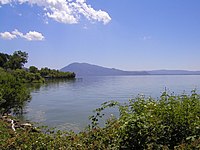
Photo from wikipedia
Lead tops the list of developmental toxicants released by industry into the environment according to Commission for Environmental Corporation. Hydrilla verticillata is an aquatic weed and rich source of variable… Click to show full abstract
Lead tops the list of developmental toxicants released by industry into the environment according to Commission for Environmental Corporation. Hydrilla verticillata is an aquatic weed and rich source of variable nutrients and chemical constituents like saponins, vitamins, minerals, antioxidants, amino acids, detoxifying agents, etc. This weed is used in a beneficial way to detoxify lead in fish model. The fish were treated with sublethal concentration of lead to induce liver damage and fed with supplementary feed containing 20% of hydrilla dry powder. The present work revealed that lead accumulation is highly toxic to liver. Lead toxicity increased the expressions of cytochrome P450 1 A (CYP1A) and cytochrome P450 3 A (CYP3A) when compared to control. The metal binding stress proteins, heat shock proteins (Hsp60 & Hsp70) and metallothionein were also upregulated due to lead toxicity. Lead intoxicated fish exhibited reduced δ-aminolevulinic acid dehydratase activity in the blood, leading to reduced red blood cell count and changes in cell morphology. The lead toxicity also decreases the level of liver marker enzymes alanine transaminase, aspartate transaminase in serum. In hydrilla supplemented protective group, there was amelioration of these changes. Administration of supplementary feed to the lead intoxicated protective group significantly decreased the expressions of CYP1A, CYP3A, Hsp60, Hsp70 and metallothionein genes. The red blood cell count in lead intoxicated fish was maintained almost normal due to the protective action of Hydrilla verticillata in the diet. The observed increase in the enzymes, which further confirmed the protective effect of Hydrilla verticillata against lead induced toxicity.
Journal Title: Drug and chemical toxicology
Year Published: 2020
Link to full text (if available)
Share on Social Media: Sign Up to like & get
recommendations!